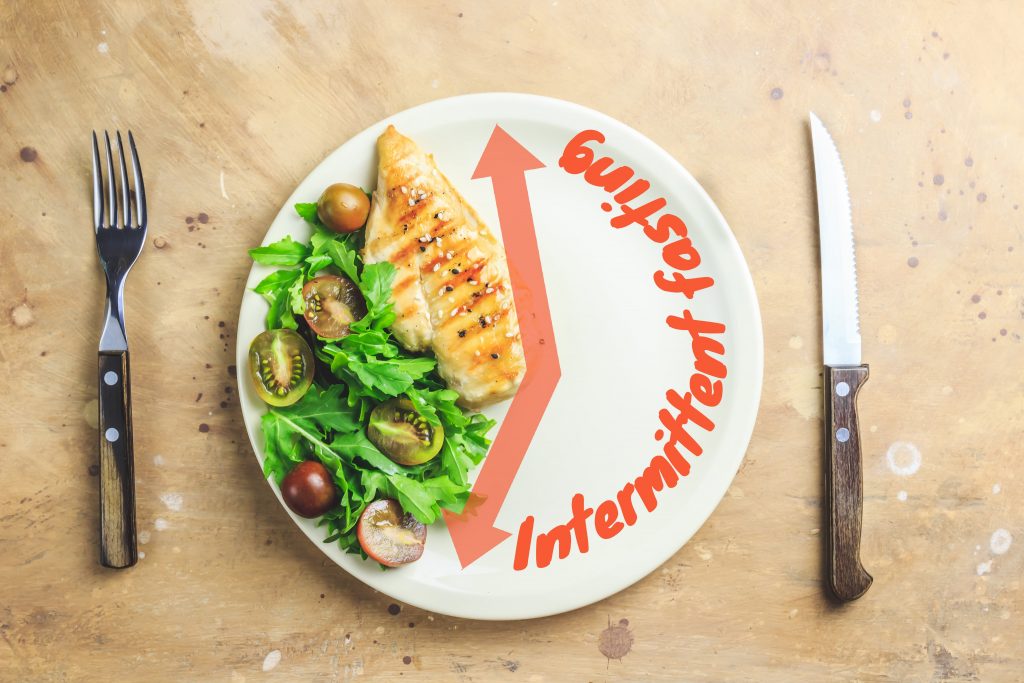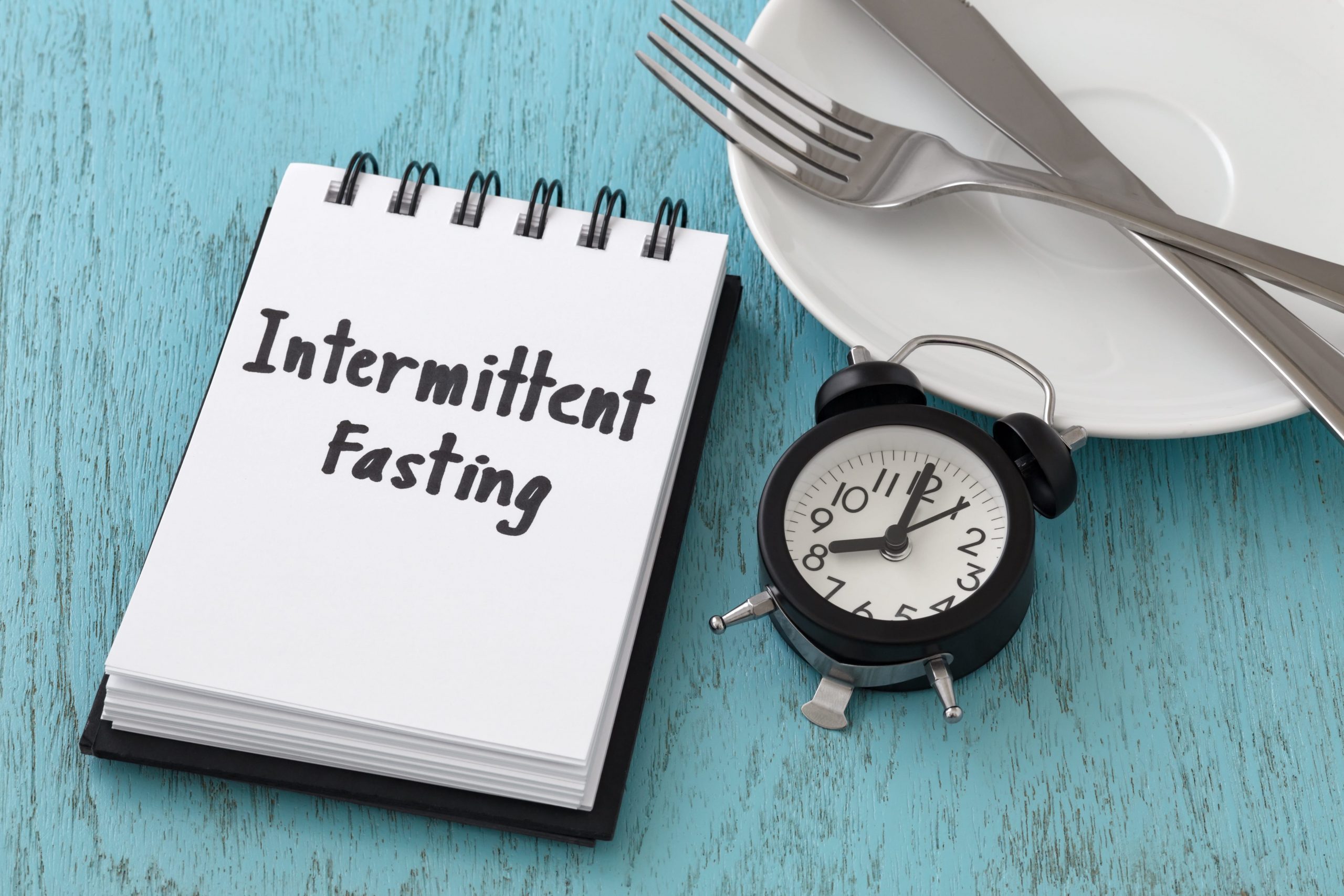Welcome to intermittent fasting 101. Here I will explain everything you need to know about intermittent fasting (IF) including health benefits of IF, the different methods/options and how to determine which IF method is best for you.
Not All Diets Are Created Equal
It never fails: I open my laptop in the morning while I sip coffee and check social media. My feed overflows with friends latching on to new, trendy diets.
These diets tend to be challenging to adhere to, and they aren’t meant to last forever. Often, once you stop the diet, the pounds that melted away come right back.
Luckily, not all diets end this way. Allow me to introduce you to “Intermittent Fasting!”

What Is Intermittent Fasting?
To understand Intermittent Fasting, you must understand the 2 states your body enters. These are the fed state and fasting state.
When you think of fasting, you might think of disciplined monks who fast religiously. But everyone enters a fasting state regularly. Fasting can be anywhere from a few hours to days. We usually enter the fasting state a few hours after dinner up until “breakfast” when we break our fast.
Once we eat, we enter the fed state. In this state, our bodies create insulin, which prompts the storage of glucose in your liver. When glucose is available, it’s used as the primary energy source. Excess glucose is stored in fat cells, which isn’t as simple to burn away.
When you extend your fasting state, your body turns to the glucose stored away in those fat cells for energy. This way, you burn off stubborn fat rather than just glucose from your meals.
Intermittent fasting allows a condensed window of time to consume your daily calories. Several methods exist to fit different schedules or time preferences. For example, the 16:8 ratio, or “Leangains Method,” allows an 8-hour window for eating. You fast during the remaining 16 hours.
But, what sets intermittent fasting apart from other diets?

Intermittent Fasting 101 – Benefits
Ease of Adherence
Many people who struggle with typical diets find success with intermittent fasting. The methods are customizable and allow for flexibility. It eliminates the drastic calorie restrictions that set many diets up for failure. It doesn’t limit your options or exclude any food items.
It also pairs well with any dietary restrictions or plans you use. If you want to enhance your Keto diet, intermittent fasting is perfect! If you’re paleo, vegan, gluten-free, no problem!
If you’re not using a specific plan, here are some excellent tips!
How To Maximize Your Fasting Benefits
- Determine your goals. Are you looking to lose weight? Gain muscle? Cutting or bulking?
- Use a calorie calculator that factors in your goal to find your daily caloric needs.
- Calculating your macros can help establish specific nutrition goals. Adjusting your intake of protein, fat, and carbs can boost your results.
Weight Loss & Improved Body Composition
Triggering your body to burn fat cells can be a powerful weight-loss tool. As a bonus, it trims the unwanted weight while maintaining your muscle mass. This makes it popular among casual gym goers and professional athletes alike.
Fasting also promotes the release of the Human Growth Hormone (HGH). This hormone stimulates lean muscle development.
Potential Health Benefits
Intermittent fasting has shown promising potential for some health conditions.
People with insulin resistance have a higher risk of developing Type 2 Diabetes. Studies show that fasting may fight insulin resistance to reduce diabetes risks. If you have insulin resistance or diabetes, consult your doctor before starting a new diet! Since fasting can trigger ketosis, diabetics must be cautious.
It may also promote heart health. Insulin resistance, inflammation, and “bad cholesterol” levels are risk factors for heart diseases. Fasting may reduce these risk factors and keep your ticker ticking.
Plus, fasting nourishes cell health and regeneration. This can lead to anti-aging and longevity benefits!
How To Start Intermittent Fasting
As I mentioned before, it’s good to start with a clear goal in mind. This goal will help you choose which fasting method to use and how many calories you’ll need.
It is always best to speak with your doctor before making significant dietary or workout changes. This is especially true if you have medical conditions or take daily medications.

Choosing Your Method
Most intermittent fasting routines resemble the Leangains by creating a daily ratio of fasting to fed hours.
-16:8 (Leangains). This method is great for beginners who need to adjust to fasting. As the name implies, plans like this support lean muscle mass with a healthy rate of fat loss.
-20:4 (The Warrior Diet). In this method, you spend 20 hours fasting with a 4-hour window for eating. The extended fasting hours boost your fat loss but can be a challenge.
-One Meal A Day (OMAD). Rather than spreading out meals over a time frame, some prefer to get their calories all at once. Generally, this is paired with a small calorie deficit or by eating only the calories you burn that day.
–5:2 Method. This method goes by days instead of hours. For 2 days of the week (non-consecutive), you only consume 500-600 calories. During the other 5 days, you eat only the calories you burned.
-24+ hour fasts. These fasts achieve significant results, but they’re not for everyone. The hunger can cause discomfort or foil your weight loss plans if you’re unable to stick with it.

Intermittent Fasting 101 Recap And Key Points
- Be realistic! If you expect crazy, miraculous results, you will sabotage yourself. Losing weight too fast can harm your health. And, if you choose an extreme method, the drastic changes can lead you to give up.
- Give it time. Follow your chosen method for at least a month to assess if it is working. Start at a less advanced method, then move to a different method after the month is over if necessary.
- Your overall health and nutrition still matter. Changing the time that you eat won’t fix much if you still eat junk, get poor sleep, or don’t exercise.
- Safety is the top priority. Communicate with your doctor and stop fasting if you experience any unusual symptoms.
Check out an in-depth guide of intermittent fasting 101 if you need more information!
Alex is a former Personal Trainer and the go-to guy when it comes to his blog – SuppsAdvisor.com.
He is very much into sports activities such as tennis, skiing, surfing and of course working out.
His motto: be active, healthy, and happy!

